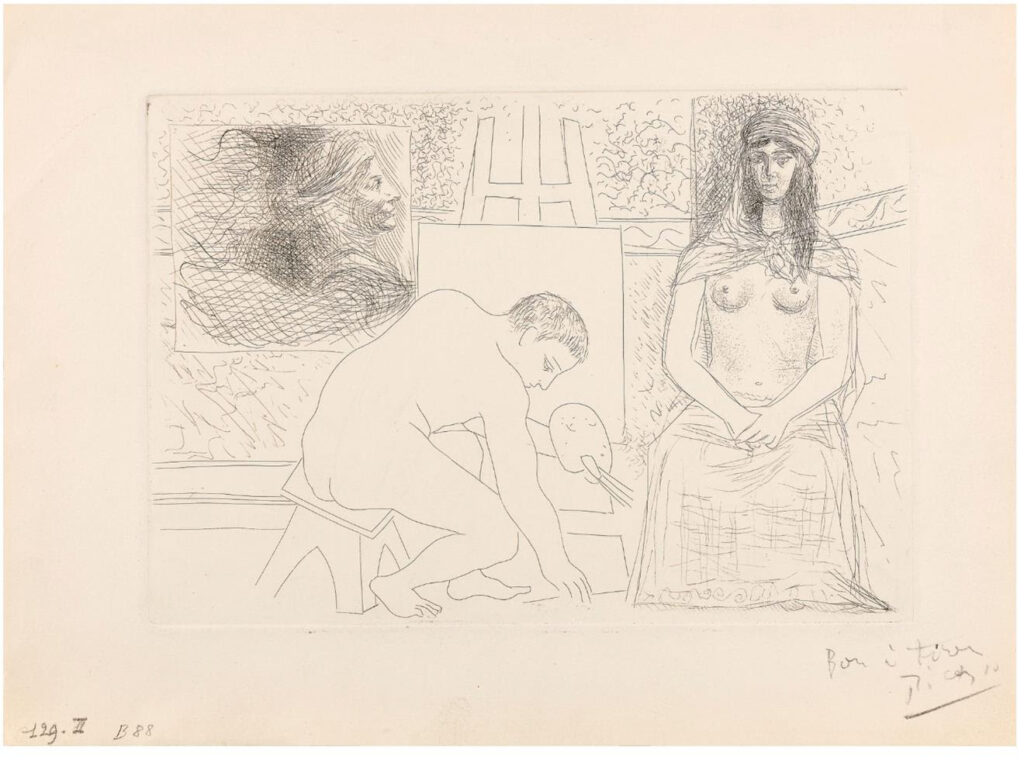
This print is from Picasso’s illustrations of Balzac’s “Unknown Masterpiece,” or “Le chef-d’œuvre inconnu” in French.* The short story was first published in a newspaper called L’Artiste in 1831 under the alternative name “Maître Frenhofer.” Taking place in the 17th century, its plot centers around a fictional old master named Frenhofer (hence the original title). He is meant to be the greatest painter of his generation. The real-life painters Poussin and Pourbus are two of his greatest admirers and apprentices. He confides a secret project to them but will not reveal it so the young men scheme to find him a beautiful model to help inspire its completion. The tale ends with the revelation of “Unknown Masterpiece” which turns out to be the work of a man losing his mind, described as “a mess of lines and layers of paint.”** The only recognizable element of the painting was a foot.
The scene depicted in Bloch 88 shows Poussin in the process of painting Mary of Egypt, as he does in Balzac’s story. Though it might seem too scandalous for a Christian saint to be shown nude, this was typical for her iconography both in illustrations and sculptures. What is odd, however, is that the 5th-century holy woman could be sitting in the same room as a 17th-century Baroque painter. Well, the rational mind might argue, she must be the model! Yet, we cannot forget the mystical, other-wordly qualities of the “Sculptor’s Studio” prints which possess parallel themes to this series like the relationship between artist and model/muse and the studio as a sacred space. In the “Sculptor’s Studio,” art literally comes to life. It seems the same fantasy rules (or lack thereof) apply here. Even in Balzac’s source material, paintings can, at least metaphorically, come to life. When Poussin shows Fernholder his portrait of the same saint, he adds some extra detailing to her eyes that suggests an unreal lifelikeness.
Many Modernists, including Cézanne*** and Picasso, were drawn to the story, identifying with Frenhofer’s willingness to sacrifice his entire life for his work. There is also an irony in the young masters denouncing what we now might call an abstract masterpiece, thanks to the generations that followed. Was Frenhofer truly mad or misunderstood? This is the question for every great visionary to ground themselves with. While Picasso was extremely famous and acclaimed in his lifetime, he also faced his fair share of criticism, making it easy to align his plight with that of Balzac’s protagonist. Not only did Picasso work with his publisher Ambroise Vollard on these illustrations but he was so fascinated by Frenhofer that he moved to Rue des Grands-Augustins where the story took place. He lived here during the war, and even painted Guernica inside its walls.****The artist later claimed to have been haunted by Balzac but it’s unclear whether this was meant literally or metaphorically. Either way, the influence “Unknown Masterpiece” had on Picasso is undeniable.
*Gagnebin, Murielle. “ÉROTIQUE DE PICASSO.” Esprit (1940-), no. 61 (1), 1982, pp. 71–76. JSTOR, Accessed 9 Sept. 2024.
**Mark Harris (1996). “Balzac’s Unknown Masterpiece”
***Kear, John, “‘Frenhofer, c’est moi’: Cézanne’s Nudes and Balzac’s Le Chef-d’œuvre inconnu”, Cambridge Quarterly, Volume 35, Issue 4, pp. 345–360. JSTOR 42971760
**** “PICASSO’S STUDIO, 7 RUE GRANDS AUGUSTINS, PARIS”. Museo Nacional Centro de Arte Reina Sofía. Retrieved 12 March 2021.
Courtesy of John Szoke Gallery.
